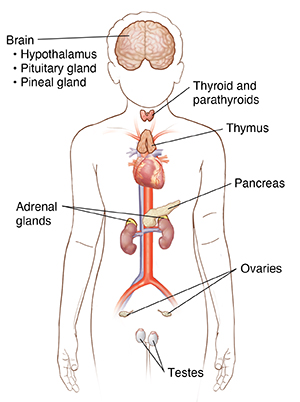What is the immune system?
The immune system protects your child's body from outside invaders. These include germs such as bacteria, viruses, and fungi, and toxins (chemicals made by microbes). The immune system is made up of different organs, cells, and proteins that work together.
There are 2 main parts of the immune system:
These 2 immune systems work together.

The innate immune system
This is your child's rapid response system. It is the first to respond when it finds an invader. It is made up of the skin, the eye's cornea, and the mucous membrane that lines the respiratory, gastrointestinal, and genitourinary tracts. These all create physical barriers to help protect your child's body. They protect against harmful germs, parasites (such as worms), or cells (such as cancer). The innate immune system is inherited. It is active from the moment your child is born. When this system recognizes an invader, it goes into action right away. The cells of this immune system surround and cover the invader. The invader is killed inside the immune system cells (called phagocytes).
The acquired immune system
The acquired immune system, with help from the innate system, makes special proteins (called antibodies) to protect your body from a specific invader. These antibodies are developed by cells called B lymphocytes after the body has been exposed to the invader. The antibodies stay in your child's body. It can take several days for antibodies to form. But after the first exposure, the immune system will recognize the invader and defend against it. The acquired immune system changes during your child's life. Immunizations train your child's immune system to make antibodies to protect them from harmful diseases.
The cells of both parts of the immune system are made in different organs of the body, including:
-
Adenoids. Two glands located at the back of the nasal passage.
-
Bone marrow. The soft, spongy tissue found in bone cavities.
-
Lymph nodes. Small organs shaped like beans, which are located all over the body and connect via the lymphatic vessels.
-
Lymphatic vessels. A network of channels all over the body that carries lymphocytes to the lymphoid organs and bloodstream.
-
Peyer patches. Lymphoid tissue in the small intestine.
-
Spleen. A fist-sized organ located in the belly (abdominal) cavity.
-
Thymus. Two lobes that join in front of the windpipe (trachea) behind the breastbone.
-
Tonsils. Two oval masses in the back of the throat.
How do antibiotics help fight infections?
Antibiotics can be used to help your child's immune system fight infections by bacteria. But antibiotics don’t work for infections caused by viruses. Antibiotics were developed to kill or disable certain bacteria. That means that an antibiotic that works for a skin infection caused by a certain bacteria may not work to cure diarrhea caused by a different bacteria. Using antibiotics for viral infections or using the wrong antibiotic to treat a bacterial infection can help bacteria become resistant to the antibiotic so it won't work as well in the future. It's important to take antibiotics as prescribed and for the right amount of time. If antibiotics are stopped early, the bacteria may develop a resistance to the antibiotics. Then the infection may come back again and be harder to treat.
Most colds and acute bronchitis infections won't respond to antibiotics. You can help decrease the spread of more aggressive bacteria by not asking your child’s healthcare provider for antibiotics in these cases.